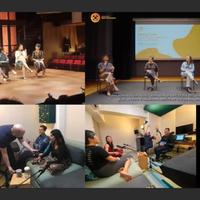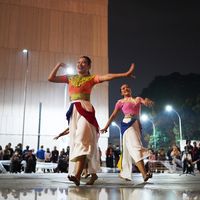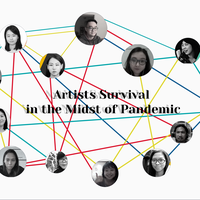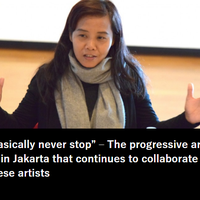Performance Making during a Pandemic: Of Innovation, Form and Embeddedness

If arts panel discussions are meant to reflect the times, “Critical Responses to Performance-Making in A Post-Pandemic World” positioned itself well: at this stage of the pandemic, it was less about open-ended contemplation of how the performing arts can retain vitality amidst the prohibitive circumstances, and more about sharing examples of performances that exemplify the act of moving ahead despite the barriers.
Held in conjunction with the Asian Art Media Roundtable (AAMR), co-organised by Karakoa and ArtsEquator as part of Creators Cradle Circuit 2021, the panel could be described as a whirlwind tour of pandemic-era performances, shared by panelists Uchino Tadashi and Yoshitaka Mori from Japan, Parichat Jungwiwattanaporn from Thailand and Helly Minarti from Indonesia. You can watch the entire panel on YouTube here.
Setting the stage for the discussion was moderator Carmen Nge from Malaysia (a speaker at the last panel on critical writing training), who underscored that Asian artists, having not been spared the ravages of COVID-19—though the pandemic experience differs by country—are nonetheless still persevering with their work.
Three keywords that come to my mind in reflecting on the panel are innovation, form and embeddedness. Innovation in presentation, form as a deeper reflection of the experience, and embeddedness as contextualisation of the performances within national spheres.
Prefacing his presentation, Uchino Tadashi stated something that sounded almost surreal to arts communities in other countries: the performing arts scene in Japan is now at its pre-pandemic levels, and never had to contend with strict lockdowns. As a result, Uchino commented that there is no corpus of innovations, which he described as “Zoom theatre”, to speak of from the country.

Eraser Fields by chelfitsch & Teppei Kaneuji | Source: chelfitsch
Nevertheless, a few examples of innovative performances were presented. In Eraser Fields written and directed by Toshiki Okada, pre-recorded performances of artists in their own living confines were presented online. The production’s website stated the guiding question as such: “Can we use theatre to present a world in which objects are equal to people rather than trapped in their usual subservient relationship?”
Another example was Moshi Moshi, Not I by Kamome Machine, which was presented in person at Waseda University’s “Lost in Pandemic” exhibition. Visitors had to answer a ringing smartphone, and the person on the other line proceeded to recite lines from Samuel Beckett’s Not I, a short monologue centred on a stream of consciousness narration. Uchino noted how disoriented and lost it made him feel. Unsure whether the voice was live or pre-recorded, he did not know what was expected of him: to talk back, keep on listening or hang up? The boundaries between the performative and participatory were blurred.
If innovativeness is measured by how remote performances are able to reach across space to create a shared experience between performers and audience, then two out of the eight performances presented by Parichat in her sharing of recent notable works deserve mention.
Dance Offering by Kornkarn Rungsawang | Source: Kornkarn Rungsawang
In Dance Offering by Kornkarn Rungsawang, a short piece presented as part of 14 in the Esplanade da:ns festival in Singapore this month, a Thai custom of making requests and presenting gifts to deities was simulated on a digital platform. A shrine dance was presented on Facebook Live, during which the audience could chat or interact with the admin. Offerings in the form of online stickers could be purchased and presented, and the dancer could be hired by individual audience members to perform additional routines.
Part of the Bangkok International Performing Arts Meeting (BIPAM) 2021, A Perfect Conversation was a joint performance by Thailand’s Sasapin Siriwanij and Eng Kai Er from Singapore. Billed a “multi-platform, online interactive experience,” it used Google Docs, video clips and the platform Pheedloop to allow the audience to interact with the performers while they viewed the pre-recorded performance together. You could call it a concurrent performance and audience talkback. (Read ArtsEquator’s review about the work here.)
In her reflections as a guest jury member for Helatari, a dance festival organised by Jakarta’s Salihara Arts Centre, Helly enjoined deeper consideration of form when adapting to the online world. Beginning her presentation with an overview of the dance film genre in Indonesia, she observed that many Indonesian dancers seemed to struggle with crafting performances which could be considered “dance films”, as opposed to Instagram Live clips, for example.
.png)
Screenshot of Pesona by Eka Wahyuni | Source: Salihara Arts Center
Her view on the four Helatari choreographers selected from a total of 51 proposals— Densiel Lebang (Jakarta), Eka Wahyuni (Yogyakarta), Krisna Satya (Bali) and Leu Wijee (Jakarta)—was that each demonstrated distinct experimentation vis-à-vis form and presented their own language and limitations to explore. For example, in her piece Pesona, Eka Wahyuni appeared more conscious of the role of the camera as a collaborator, or as its own entity with a gaze that needs to be negotiated with as part of the choreography.
Embeddedness refers to the notion that the arts are never far from society. The arts reflect and are constrained by society, and also amplify the latter’s fault lines in times of crisis. Speaking of global division in the form of technology divergence, Yoshitaka Mori used the example of China, where Zoom is not available. In his experience, sharing art with Chinese audiences is then obstructed.

Parichat shares about how street protests were a kind of performance during the pandemic.
An example from Japan drove home the message of how pandemic performance-making can leave many out. For the past 30 years, on New Year’s Eve Drifting Sisters/Aquarium Theatre organises a street theatre show in Yoseba, a working-class area in Tokyo. However, during the pandemic, the option of going online was unavailable as the area’s residents were mainly senior citizens who did not possess smartphones. So the 30-year run ended, and the residents did not get to enjoy the performance.
The embeddedness of the arts in politics was brought up by Parichat in her presentation. She posited that during the pandemic, there were only two types of ‘performances’ in Thailand: street protests and online performances. However, she noted that protests against the military government slowed down due to the pandemic, leading to charges that the government was abusing the restrictions for political gain. It was this backdrop of sociopolitical and economic hardship that Parichat stressed, in understanding the added challenges that Thai artists had to overcome in continuing to create.
It was a statement that resonated.
The panel Critical Responses to Performance-Making in A Post-Pandemic World took place on 22 Sep 2021, as part of Asian Arts Media Roundtable @ Creators Creators Cradle Circuit 2021 in partnership with BUoY Festival in Tokyo. It is co-organised by Karakoa and ArtsEquator. The Asian Arts Media Roundtable (AAMR), a meeting of arts writers from Southeast Asia, East Asia and Asia-Pacific, was founded by ArtsEquator in 2019.
Adriana Nordin Manan is a writer, playwright, translator, and researcher. Born, raised, and based in Kuala Lumpur, she is fascinated by the expanse of stories as mirrors to society and monuments to the human condition. In 2019, her translation of “Pengap” by Lokman Hakim was shortlisted for The Commonwealth Short Story Prize, a first for Malay language submissions. She is currently working on her first full-length play, with themes of cultural clashes, diaspora, and family conflict. Adriana speaks Malay, English, and Spanish.
Similar content
deadline
15 Aug 2021
13 Dec 2022
17 Sep 2021
posted on
01 Jun 2016






